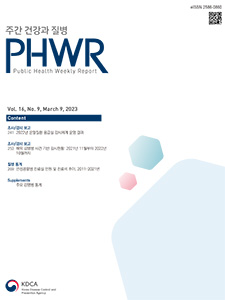Current Issue
Vol.16 No.9, March 09, 2023
-
Surveillance Reports 2023-03-09
 2
2
 9844
9844
 666
666
Results of the 2022 Heat-related Illness Surveillance
Seongwoo Park, Joo-Yeon Hwang, Hyoeun Kim, Youngju Lee, JongHee Kim, Younjhin Ahn*
Public Health Weekly Report 2023; 16(9): 241-252 https://doi.org/10.56786/PHWR.2023.16.9.1 Abstract
AbstractThe Korea Disease Control and Prevention Agency has been monitoring the incidences of heat-related illness (HRI) during the heat waves every summer via the HRI Surveillance System since 2011. During 2022 (20 May–30 September), a total of 1,564 cases of HRI were reported to the surveillance system including an estimate of nine deaths. In the summer of 2022 (May–September), the average heat wave days was 10.6 days, which was 10.2% lower than the summer of 2021. However, the incidence of HRI rose by 13.7%. The average daily maximum temperature in early July 2022 was 32.0℃, which was 4.3℃ higher than the previous year. During that period, 33% of all HRI occurred due to an early heat wave. Of the reported patients with HRI, there were more men than women, and the most commonly affected age group was 50–59 years. HRI occurred outdoors 4.6 times more frequently than indoors. Furthermore, HRI most commonly occurred in outdoor workplaces. There were an estimate of nine reported deaths in 2022, which was 55% lower than that in the previous year, and the reported estimated cause of death was heatstroke in all cases. Health hazards from heat waves caused by climate change are anticipated to rise continuously. Consequently, the importance of health surveillance and information sharing will become increasingly important.
-
Surveillance Reports 2023-03-09
 0
0
 997
997
 225
225
Event-Based Surveillance of Foreign Infectious Disease Outbreak: from November, 2021 to October, 2022
Yongmoon Kim, Bryan Inho, Jia Lee, Jiyoung Oh, Seonyoung Lee, Soohyun Kim, Sujin Hong, Geehyuk Kim, Chungman Chae, Sangwoo Tak*
Public Health Weekly Report 2023; 16(9): 253-268 https://doi.org/10.56786/PHWR.2023.16.9.2 Abstract
AbstractThe Division of Risk Assessment in Korea Disease Control and Prevention Agency has operated event-based surveillance (EBS) for early detection of foreign infectious disease outbreak and risk communication. In this report, we analyzed descriptive statistics of events which is registered on EBS database from November 2021 to October 2022 and present the descriptive statistics of the collected events using several criteria, including collection time, data sources, disease type, continents affected by outbreaks, and communication. In discussion, we address the need to enhance speed, accuracy and precision in detecting infectious disease outbreak events. Additionally, we propose expanding local public health network, active information sharing between open-source epidemic intelligence system users and training experts on EBS as solutions to improve current EBS.
-
QuickStats 2023-03-09
 1
1
 1649
1649
 276
276
Trends in the Number of Chronic Kidney Disease Patients and Medical Expenses, During 2011–2021
Public Health Weekly Report 2023; 16(9): 269-270 https://doi.org/10.56786/PHWR.2023.16.9.3

pp. 1433~1461
Most Keyword
?
What is Most Keyword?
- It is the most frequently used keyword in articles in this journal for the past two years.
Most Read
-
Waterborne and Foodborne Disease Outbreaks in the Republic of Korea, 2023
Myung-Jae Hwang, So Yeon Park, Hyungjun Kim, Se Jeong Yang, Sungchan Yang, Jin Seon Yang
Public Health Weekly Report 2025;18: 17-32 https://doi.org/10.56786/PHWR.2025.18.1.2 -
Implementation Plan for the Coronavirus Disease 2019 Vaccination for the 2024–2025 Season: Recommendations of the 6th Expert Committee on Immunization Practices
Hyewook Hwang, Wookeon Lee, Seohyeon Ahn, Young-Sook Choi, Seunghyun Lewis Kwon, Dongwoo Lee, Eun Hwa Choi, SokGoo Lee
Public Health Weekly Report 2025;18: 90-102 https://doi.org/10.56786/PHWR.2025.18.2.3
Editorial Office
+82-43-719-7569





 Full Text
Full Text Cite
Cite


